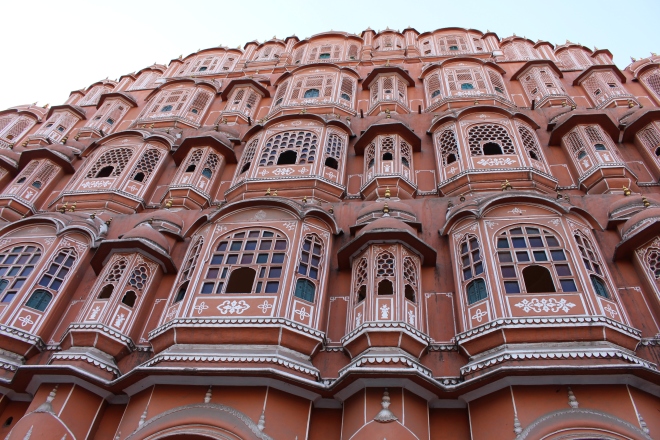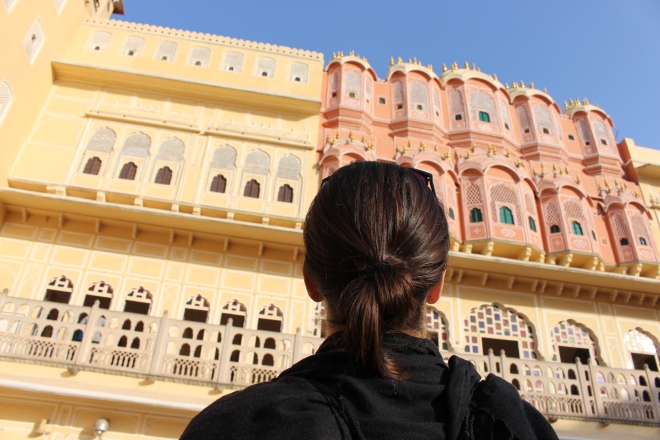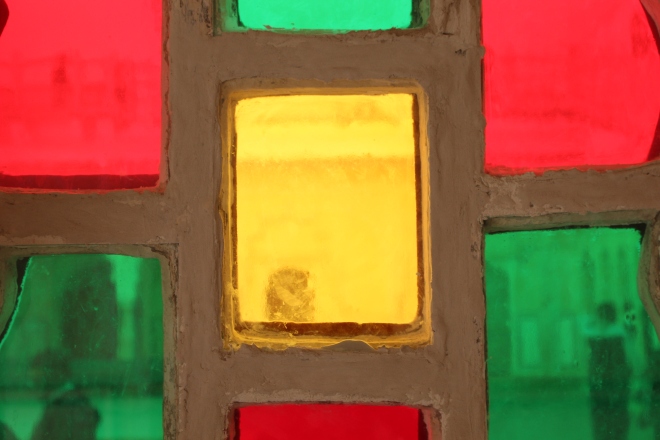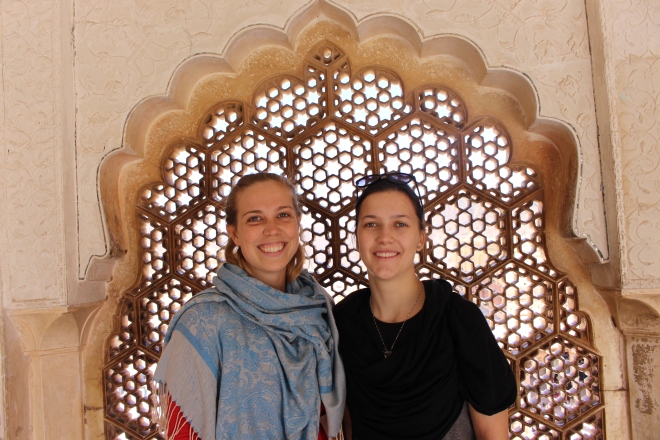As I write this, I’m transported back in time to one moment. I’m standing at the very top of Hawa Mahal, squeezing sideways through a doorway that forces me to pull my head in, focusing on a tiny window in the wall in front of me. The wall is of a rusty-pinkish colour. Peeking out the window, I can see the street beneath us, the people walking by, the cars driving and stopping. It’s not an amazing sight, it’s nothing out of the ordinary, but to the women who stood in this very position 200 years ago, it must have been special.
The journey to Jaipur took us 22 hours on the train. We arrived at the Hostel by 12pm on the 3rd of February. The room was a 6-bed female dorm room, equipped with a shared bathroom. We took the two adjoining higher bunks and quickly freshened up to hit Amber Palace. On the way to the city, I noticed that I had forgotten to bring a charger for the phones. Neither mine, nor Jule’s phone had enough battery to take us to Amber Fort and back. Adding to our general exhaustion from the train ride, my error made us rethink the plans for the day and we decided to take a sightseeing stroll through Jaipur’s Pink City, Bazaars and visit Hawa Mahal and the other landmarks. Of course one might think: just go without your phone. You can’t be that dependent on it. Well…
My phone has been an essential part of my life here. Of course a phone is a dangerous thing, compromising my privacy, toxic rays and whatnot… But it has made life easier and maybe even kept me out of danger. Or at least I like to tell myself that.
I’ve been skeptical of Cloud Computing and uploading my important documents to a phantom space on the internet and hoping no-one will find it. I still don’t like the thought of uploading it but it makes me feel safe to know that I can access copies of my Visa, my Passsport and my Registration from any computer that has access to the internet, including my phone. Also, I’m using my phone to navigate around all the new places and – most importantly – I can get a Taxi to anywhere I’m standing. This saves time on a tight schedule and guarantees me to drive with a Taxi company that is registered and equipped with an SOS helpline in case anything goes wrong (which it never has). We’ve also kept copies of pages from the travel guides on the phones so we don’t use up space and kilos with big books. This helped us find an alternative to Amber Fort in five minutes. We had taken some pictures of the Lonely Planet guide and kept them on our phones.
Lonely Planet suggested a walking route through the city that would take us along all the interesting roads and past the Hawa Mahal, City Palace and Jantar Mantar. We started at the cross of two huge streets. My first thought was: What a stressful place, I hope the day passes soon. But the longer we walked and the smaller the roads got, the more I started loving the afternoon. Pink City is obviously not really pink. The buldings were rusty-coloured with a touch of faded, dark rosé. Some of them were quite ornamental. Along the main Bazaars, small shops, maybe the size of garages, were lined up. Different bazaars were famous for different things: jewellery, fabrics, metal parts, the list goes on.
The word “Hawa” translates to “air”. So naturally, the Hawa Mahal has become known as the “Palace of Winds” or the “Palace of Breezes”. There are few rooms that are completely sealed. Open doorways, clusters of small and big glassless windows on all sides of the rooms and open courtyards allow the air to swish through the rooms, creating a breeze throughout the whole bulding. The windows are beautiful. Some of them are simply holes in the walls while others are made up of tiny holes arranged in ornamental grids. The Hawa Mahal was built in the late 18th century. As I understand it, its main purpose was to allow the royal Rajput women to catch a glimpse of everyday life, while remaining with the restrictions of the “Purdah system” that prohibited them from appearing in public unveiled.
I’ve read a lot of different articles on the Rajput people. It is difficult to say when the idea of “Rajput” emerged and what exactly it refers to. Simply and most commonly put: the term Rajput refers to several clan-like communities of warriorhood dating back to the 11th and 12th century. Until the 20th century, Rajput kingdoms played a big role in Northern and Central India. Once based on a military structure and affiliation, being a Rajput has long been determined by blood relation. As the women have to follow the Purdah system, the system rstricting women from walking in public unveiled, the big facade of Hawa Mahal that can be seen from the main road was deisgned. Though it is not the “front” of the building, it is the most memorable feature visible to the outside. This facade is only about 3-4 metres thick and serves only the one single purpose of allowing unnoticed glimpses onto the street beneath.

So there I am, peeking through one of these tiny windows. To be honest, I am always more captured by monuments that are not so closely linked to religion. Because I am neither Hindu nor Moslem, I usually have a hard time relating to these places and making a connection. I left Hawa Mahal feeling fascinated. It is a detailed and beautiful building. I was stunned that they let us roam around almost every single room and corridor freely. I can imagine there being more restrictions in some other countries, among them Germany. As the sun was burning down and the temperatures high, we decided to go for an iced coffee. To our surprise, one of the rooms that adjoining the courtyard had been rented out to a coffee chain and completely renovated, something which I also believe would not necessarily be done in other places.

Next on our map was another shopping street. Shops were lined up on each side of the road. Most of them are selling similar, if not the same products: shals, Kurtis, wooden artwork, jewellery, bags… Colourful and decorated, all of it. I was drawn to a black cotton shal that was embroidered with red, green, yellow and blue lines, and was decorated with small, round, silver plates and fine golden patterns. Decorating fabric with small mirrors or cheaper variations of the latter is a practice typical to Rajasthan. Colourful garments and shining bags can be found everywhere and really invited us to try it out. I really liked some small round mirror pouches but didn’t buy it because I wouldn’t know what to use it for. That’s always the difficulty. I always have toask myself: are you going to wear it in Germany? Is it too much? I’ve even started wearijewellery because all the women around me are an inspiration in that sense.

It was already nearing dusk and the City Palace as well as Jantar Mantar had closed.
We decided to make our way back to the Hostel, have a rest and go for dinner. We craved burgers and picked a burger place nearby. What we didn’t realize was that it was actually located inside the Holiday Inn Hotel. Quite a fancy place. I felt very out of place in my loose pants and sweater but we decided to go in anyways to treat ourselves after the long train ride. The restaurant wasn’t expensive and the food was good. Feeling satisfied and exhausted we dropped into bed and indulged in the wifi.
The next day we woke up, checked out of the hostel and walked to a nearby breakfast place, where we had pancakes and waffles. We then ordered a cab to take us to Amber Fort. Driving into the moderate hillside took us around 15 minutes, during which I executed my self-designated role of travel researcher to find all the information I could in 15 minutes about the Amber Palace and Fort.
Amber Palace is constructed of sandstone and marble. It is shaped by a variety of different courtyards and halls, all connected by small closed and open corridors. The Hindu construction was finished in the early-mid 16th century, once again depending on which source can be believed. Basic and preceeding structures are even dated back to the 11th century. It is an architectural and historic site that can once again be traced back to Rajput heritage. Its current structure and appearance were strongly shaped by the Rajput Raja Man Singh I in the 16th century.
As we neared the Palace I was immeditaly impressed. It is basically an arrangement of several sandy blocks of stone, some taller, some smaller, some standing out, some caving in, only interrupted by small and big glassles windows. Consisting of open courtyards and closed rooms, it leaves lots of space to roam and explore. To reach the main entrance, one has to walk through a small park next to what used to be a lake. Then one has to climb a few steps and walk up a classic paved road. Some people pay to be taken up in small yellow or red cars. Once again, it is hard to describe the architecture of the place so I’ll leave it to the pictures.
I really enjoyed walking around the palace. It’s one of those huge buildings that you can get lost in. There is always a left or a right turn, sometimes even a way up or down waiting. I would have liked to have a guided tour but since watching Slumdog Millionaire and having met real and fake guides myself I never know who to trust. So I developed a tactic where I read something about the place beforehand, take notes in my head while I’m there and then do some more detailed research on the specific things I noticed. We roamed around all the pathways and corridors and peeked into the former bathrooms. Ceilings are decorated and ornamented and there was even something like a “Mirror Hall” that loved up to its name. It was completely covered in tiny, tiny mirrors – staying true to Rajasthan. I could really feel many different influences: traditional Hindu and Rajput architecture were blended with Muslim ornamentation.
Then we made our way to the tunnel connecting the palace to the big wall that takes you up to the Fort. From the outside the construction of the wall very roughly resembles the Chinese Wall, sitting on top of a hill. Even though it wasn’t a long way up, it was a steep and hot one. When we got to the Fort entrance, we weren’t in the mood to pay another fifty rupees to enter the place. The palace was enough for us and we wanted to go to the city one more time before taking the train later. We enjoyed the view on the hills and nearby villages and walked back to the Palace. In the Entrance Park we sat down on the grass in the shade and had a rest. Afterwards we visited the Palace’s Tribal Shop, where I bought some wide-legged black pants and a pillow cover.
When we got back to the City, we walked around the streets again. Both of us bought some anklets and we asked for Kurtis, as one of ours had torn the day before. We had some dinner in quite a fancy restaurant and I tried one local dish that had been recommended by locals on the train. Daal, Baati, Churma was the name. I hated it. I didn’t like the Daal, it had little unique taste to it. The Baatis were too dry and even the Churma powder was too sweet and made with too much Ghee. We decided to spend the rest of the evening at the Hostel to relax and talk to some people. Jule had some problems with her Camera and SD cards which forced us to upload all the pictures and video to the Cloud and reformat the Cards. Soon it was dark and time for us to go to the train station. Next stop: Jaisalmer.

We arrived at the train station a little early. Jule wasn’t feeling super well, I was feeling fine. We rested our backs against our backpacks on the ground and waited, it was already 12 in the night. The train arrived and we didn’t find our compartment. It was B4 but there was no B4 in sight. We ran in both directions, desperately trying to find B4. The train started rumbling and we had to make a choice. We entered one compartment, searching for any signs of B4 but were shocked by the bad condition of the Sleeper Car.
In India, you can book in several classes: Seating Car, 1st AC, 2nd AC, 3rd AC and Sleeper. Sleeper is the lowest class and I believe the most dangerous one to be in. Nevertheless we booked it because usually when we find our fellow travelers to be friendly and helpful people. But this time, having to enter the compartment in the dark, not being able to see who the people were that would be sleeping next to us, it was a little too much. We decided to jump into 1st AC, which is first class, and wait there.
Jule was still not feeling too well and we were both not too sure what to do. After all, B4 had to exist somewhere, right? Standing in front of the toilets in first class, the Ticket Man soon noticed us. We asked him for help and explained to him what had happened. He told us to wait and go to B4 at the next station, which was 30 minutes away. He wasn’t very helpful but I also think he didn’t understand how clueless we really were. The train was extremely long and we would only have 2 minutes at the next station to run to the back. Luckily we weren’t alone in our misery. A man, around 30 years old, was also romaing around the toilets and didn’t have a place to sit. He did have a valid ticket but hadn’t progressed far enough on the waiting list to get a seat. He talked to the Ticket Man and decided to help us. He said he was a slodier and we could trust him. While they were talking, Jule and I both felt a little anguished.
Problems seemed to be appearing left, right and center.Our first problem was the train route: The train would split in the middle at a certain point. So we had to get to B4 and we had to get there fast to be in the part going to Jaisalmer and not to some other place. Our second problem was time: if we wanted to run to the back and find B4, we would have to run for our lives. We couldn’t be certain about how long the train was and whether we would make it there in two minutes. Simply getting into a different compartment wasn’t much of an option since we didn’t know where the train would split and we also didn’t want to spend unnecessary time in a lower-class compartment that wasn’t ours.
The third problem were our worries about the night. Not knowing and seeing the people in the compartment concerned us. The whole situation was dramatised by communication struggles and simply being in another country and not knowing our way around.
I’m happy I told myself to KEEP CALM AND THINK CLEARLY. A freak-out would have been disastrous. In order to get to B4 we had to trust the soldier. He had the build of a soldier and he showed us his military ID. The authentic stamp convinced me to just take a leap of faith – literally! We had to get out the train as fast as possible when it rolled into the next station so we jumpd out the moving train. Don’t get off your seats, the train was already going quite slowly. But still I have never jumped out a moving train so I’ll leave it at that. We ran to the back as fast as we could with the backpacks and found B4! The train, of course, rested in the station for longer than two minutes and B4 wasn’t too far away. Easy. When we entered B4 and had found our berths, there were two guys lying in them. As we hadn’t come for one station, they had probably thought we would never come. The soldier tealked to them in Hindi and after they had confirmed our tickets they left the beds reluctantly and we could climb in. It was 1:30am now.
We were all tired, Jule was still feeling a little unwell and I was still not ready to trust the guy. While Jule slept, I took the first “night shift” and stayed awake, sharing my bed with him. We made some casual conversation and eventually I lay down. I think Jule woke up as I fell asleep and without having to agree on it, we took turns sleeping and staying awake, keeping an eye on the soldier and everyone else around us.
At around 2:30am I started feeling sick. I assumed it was because of the uncomfortable position I was lying in. I started having to climb down every half an hour to go to the bathroom. I threw up for the first time at 3am and had to do so several times after. I noticed it was the Daal, Baati, Churma that I had had for dinner and which I hated. I was lucky to be in an Indian train on an Indian toilet. It was already dirty and stinking so someone throwing up wouldn’t change the situation much. No-one looked at me strangely and it was night. Eventually, at 4am, the soldier had to move back into the other part of the train. He had to be in the part going to a different place. I was happy he was gone and that I could finally sleep calmly and without worrying. When we woke up in the morning, we saw that among our fellow travelers there had been children and women, which honestly gives me comfort.
I was still feeling horrible and it took me some time to adjust to a sitting position. A man and woman who had slept under us were doctors. They were immediately concerned about my health and offered me some medicine. When I explained that it must have been the food, they told me that I shouldn’t have eaten the Daal, Baati, Churma. In the future, I will never listen to what anyone tells me to eat ever again. The train arrived at the station and I started walking, the backpack seemed endlessly heavy. I thought I felt fine until I walked past the public toilets on the platform. A few steps later, I had to stop because I started feeling nauseaus again… I knew something was brewing inside of me, I just really hoped it was over. It wasn’t. Jule looked at me, told me to leave the backpack on the ground and I started making my way to the toilets as quickly as possible. Then it came and I puked straight onto the platform. No one cared.
Sorry for all the detail. But it felt like the climax of what had been a dramatic and highly unpleasant und inconvenient night, everything had just been a lot to process. Even the food. Haha.
Sooo Jule had to channel all the energy that she had left and take over completely. I was just walking behind her and trying to get my body to function like I wanted it to. Funny enough I wasn’t feeling horrible. I was feeling bad but I was just relieved everything had gotten out. We arrived at the Hostel, I had a shower and we went straight to bed and waisted half a day. Jaisalmer had to wait a few more moments but by afternoon we were ready to explore.
Bottom Line
Jaipur, in hindsight, has turned out to be one of my favourite places. Though not obviously a favourite to pick, it is the right size for me. Yes, there’s a lot going one but I loved how lively it was. Hawa Mahal left a serious impression, so did Amber Palace.
Jule and I took care of each other. When the one was feeling bad, the otehr one took over and vice versa. Without communicating about it too much, we made a good team and that night on the train will be something to remember forever. Jaipur is a place I would definitely visit againa nd recommend to anyone who comes to India.


















